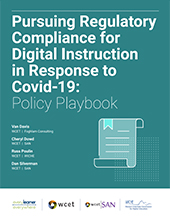Student Identity Verification
Efforts to curtail cheating on exams, plagiarism, submission of purchased essays written by others, and all forms of academic dishonesty are not only good academic practice; they are also a federal financial aid requirement. The rules also protect students who act honorably. It is a core academic responsibility for institutional personnel to ensure that the enrolled student is the one performing and completing course assessments. Although academic dishonesty can occur in all instructional modalities, federal requirements regarding student identity verification only exist in distance education. The Department of Education implemented the following requirement to protect against the perceived misuse of financial aid funds and to protect students. The regulatory language appears below:
34 CFR 602.17(g) and (h) Application of standards in reaching an accrediting decision.
(g) Requires institutions to have processes in place through which the institution establishes that a student who registers in any course offered via distance education or correspondence is the same student who academically engages in the course or program; and
(h) Makes clear in writing that institutions must use processes that protect student privacy and notify students of any projected additional student charges associated with the verification of student identity at the time of registration or enrollment.
This regulation is among the standards that institutional accrediting agencies must apply to the colleges and universities that they oversee. As a result, the accrediting agency must require that institutions have processes in place to ensure that the student who registers for a course is the same one who academically engages in the course.
Accrediting agencies may have slight, but important, variations in how they interpret this requirement and in their expectations of institutions. Faculty and administrators should review their accrediting agency’s definition of distance education. For example, accrediting agencies may differ in which courses they define as distance education courses and to which they apply this regulation.
A minor, but notable, change to this regulation became effective July 1, 2020. The previous language included examples of ways to demonstrate compliance, such as the institution providing a secure log-in or requiring students to take exams in a face-to-face setting with a proctor. However, officials were worried that some institutions provided a log-in and did nothing further regarding student identity verification. As a result, they updated the language with the intent of increasing the expectation that the accrediting agency work with the institution to identify effective processes for student identity verification.
The Notification Requirement in Section (h)
Many institutions use digital proctoring tools as a part of their student identity verification process. Institutions are required to disclose any such costs to students at the time they enroll. This allows students to calculate the full price of each course before selecting the course section. Some institutions have waited to notify the student in the syllabus or when the first exam occurs, but that is too late.
